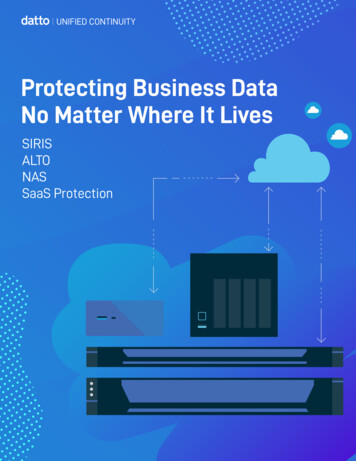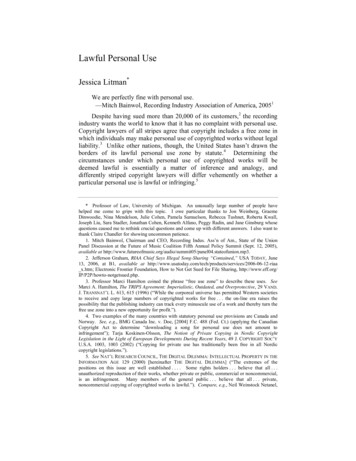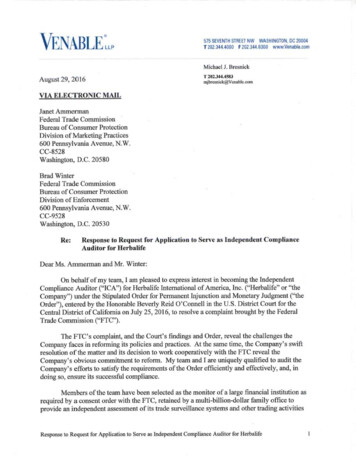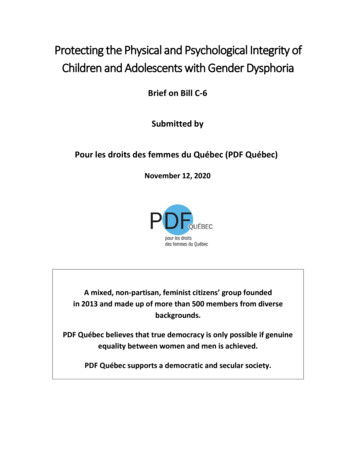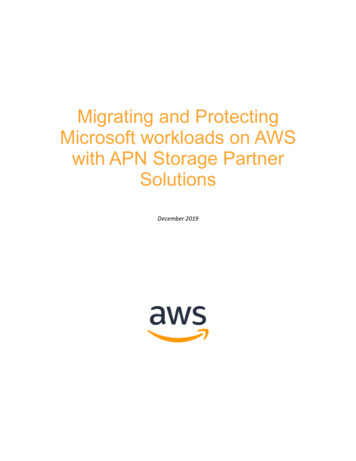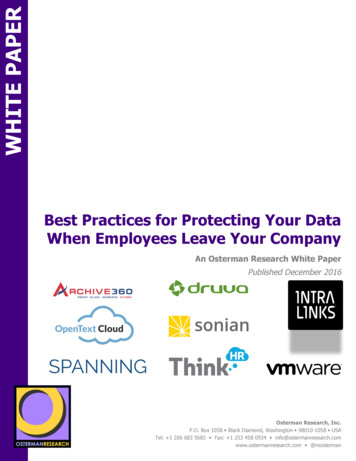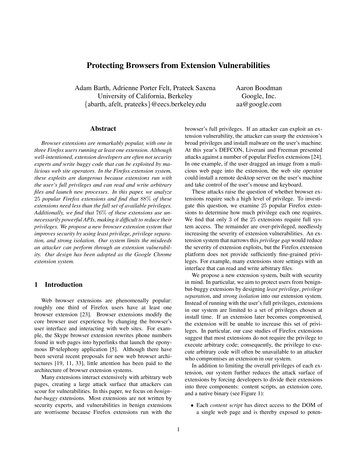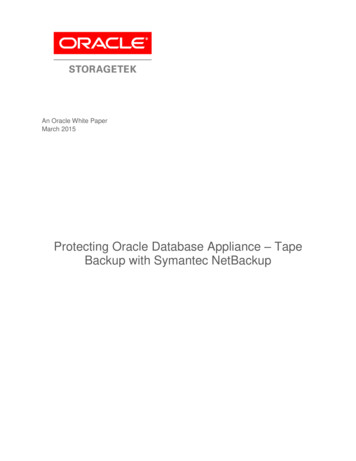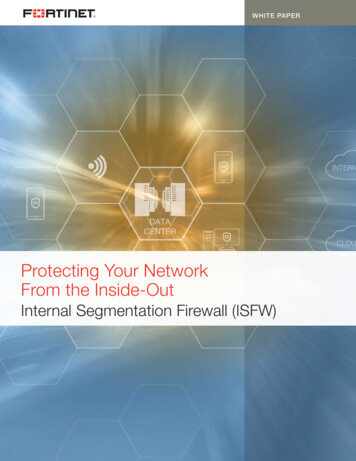
Transcription
Protecting Personal InformationA BUSINESS GUIDEDivision of Financial Regulation
Oregon Identity Theft Protection ActCollecting, sharing, and keeping personal data is essential tobusinesses, organizations, and government agencies. Cyber attackshave become increasingly common and sophisticated, so it’s notjust essential to have a plan to protect your customers and employees, it’s the law.Oregon’s Consumer Identity Theft Protection Act and relatedrules will give you clear direction and expectations to ensure thesafety of sensitive data.In Oregon, personal information includes a consumer’s firstname – or first initial and last name – in combination with theconsumer’s: Social Security number Driver license number or state ID card number issued by theDepartment of Transportation Passport number or other U.S.-issued identification number Financial account, credit, or debit card number, in combination with any required security or access code, or passwordthat would allow access to the financial account2
Physical characteristics data used to authenticate identificationduring a financial transaction such as fingerprint, retina, oriris image Health insurance policy number or health insurance subscriber identification number in combination with any otherunique identifier used by health insurers Medical history, mental or physical condition, or medicaldiagnosis or treatment by a health care professionalYour responsibility.You can assess and minimize the risks to your business and toconsumers by following the requirements contained in the OregonConsumer Identity Theft Protection Act. The law contains standards to safeguard personal information, shield Social Securitynumbers, and notify consumers in case of a security breach.The Department of Consumer and Business Services and theOregon Department of Justice enforce these laws and provideeducational materials.3
Protect dataConsumers appreciate your products and the service youprovide. They also will appreciate the measures you have in placeto effectively protect their personal information.Your responsibility.The Oregon Identity Theft Protection Act requires you todevelop, implement, and maintain reasonable safeguards toensure the security, confidentiality, and integrity of personalinformation. Safeguarding also means properly disposing ofinformation.The following steps will help you to implement an information security program that will help minimize breach risks.AssessTake inventory of all personal information you have oncomputers and files by type and location. This also includesinformation your business receives through websites and fromcontractors and others. Be sure you know what sensitive information is stored on electronic devices such as tablets, laptops,employees’ home computers, flash drives, and cell phones.As part of the assessment, test the effectiveness of yourexisting security safeguards to see if there are any foreseeableinternal or external risks with your network or thesoftware used.4
ProtectLost or stolen paper documents containing personal information make you vulnerable to a security breach. The best defense insecuring paper documents, as well as hard disks, CDs, DVDs,flash drives, tapes, and other storage media, is locking them in afile cabinet or placing them in a locked room withlimited access. Develop a plan for your employees,outlining procedures to securely store sensitive information, including if or how devices can be taken off thepremises. Encrypt sensitive information stored onlaptops. Use a firewall to protect your computersystem from attacks.ReduceIf you don’t have a need for personal information,don’t collect it and don’t keep it. If you do need it for alegitimate business purpose, design a records retention plan that outlines what information must be kept,how to secure it, how long to keep it, and how todispose of it securely once you no longer need it.TrainMake sure employees know what personal information is, howimportant it is to safeguard it, and your security program practices and procedures. Likewise, train your employees onnotification procedures in the event of a security breach.To help spread the word, designate one or more employees tocoordinate the security program.DetectRegularly assess security risks by testing and monitoring keycontrols, systems, and procedures. Look at any risk to your information storage, whether it is a locking file cabinet or electronicsystem. This will help you respond quickly to any attacks orintrusions.When selecting outside service providers, know their capabilities in maintaining appropriate safeguards and require thesesafeguards in your contract with them.5
PrepareCreate a plan for dealing with a security breach if one shouldoccur. Swift action is crucial for complying with federal and statelaws, and failing to develop a breach response plan ahead of timewill almost certainly result in missteps. The plan should include, forexample, procedures for involving the necessary service providersand professionals to evaluate and contain the breach, investigatingthe breach, preserving evidence, reporting the breach to regulatorsand law enforcement, notifying affected customers, and addressing the breach in the media.Given the prevalence of security breaches affectingelectronic information, many insurance companies are nowoffering “cyber insurance.” Explore this insurance optionand understand what coverage will and won’t do for you.DestroyProperly destroy records with personal information toprotect against any unauthorized access or use. Shred,burn, or pulverize hard-copy records, and erase anyelectronic records to make them unreadable and preventanyone from reconstructing them.Oregon’s E-Cycles program encourages everyone torecycle electronic devices, including computers, monitors,keyboards, and mice. However, before recycling, make sureall personal information on the devices is erased permanently or destroyed.More details on securing dataAccording to the Oregon Identity Theft Protection Act, asecurity program includes the following:Administrative safeguards Designate one or more employees to coordinate the securityprogram. Identify reasonably foreseeable internal and external risks.6
Assess the sufficiency of safeguards in place to control theidentified risks. Train and manage employees in the security program practices and procedures. Select service providers capable of maintaining appropriatesafeguards, and require those safeguards by contract. Adjust the security program in light of business changes ornew circumstances.Technical safeguards Assess risks in network and software design, informationprocessing and transmission, and storage. Detect, prevent, and respond to attacks or system failures. Regularly test and monitor the effectiveness of key controls,systems, and procedures.Physical safeguards Assess risks of information storage and disposal. Detect, prevent, and respond to intrusions. Protect against unauthorized access to or use of personalinformation during or after the collection, transportation, anddestruction or disposal of the information. Dispose of personal information after it is no longerneeded for business purposes or as required by local,state, or federal law by burning, pulverizing,shredding, or modifying a physical record andby destroying electronic media so that theinformation cannot be read orreconstructed.Note: Any individual, business, governmentagency, or organization that is subject to and complies withdata safeguard regulations or guidance adopted under theGramm-Leach-Bliley Act or the Health Insurance Portability andAccountability Act (HIPAA) does not need to develop additional7
processes. However, you must follow Oregon’s requirements toprotect your employees’ personal information, such as SocialSecurity numbers or financial data as HIPAA does not cover thisinformation.Protect Social Security numbersA Social Security number is a person’s most unique means ofidentification because it never changes. It also is used to link torecords that contain other sensitive information. These factorsmake the Social Security number valuable to those who commitidentity theft, and absolutely crucial to protect from disclosure.Your responsibility.The Oregon Identity Theft Protection Act prohibits anyone(individuals, government agencies, organizations, or businesses)from printing Social Security numbers on any material that ismailed when the recipient has not requested it, unless redacted.This does not apply to records or documents required by state orfederal law such as W2s, 1099s, or similar documents. The lawalso prohibits printing a Social Security number on a card used toaccess products or services, or publicly posting or displaying aSocial Security number, such as on a website. Exceptions includerecords required by state or federal law; that are used for internalverification or administrative processes; or that are used toenforce a judgment or court order.Other exceptions include: Rules adopted by the courts Copies of records possessed by a court, theState Court Administrator, or the Secretaryof StateBusinesses or organizations that use SocialSecurity numbers as an account identifier shoulduse another means to identify their customers’accounts.8
Notify consumersThe faster consumers know their personal identificationinformation has been breached, the faster they can take safeguarding precautions.Your responsibility.A person that owns, maintains, or licenses personal information used in the course of business, vocation, occupation, orvolunteer activities, must notify their customers as soon as possible that there has been a data security breach. Notification canbe made in one of the following ways: Written notification. Electronic notice, if this is the customary means of communication between you and your customers. Telephone notice provided that you make direct contact withthe affected customer.A person or company that maintains or possesses personalinformation on behalf of another must immediately notify thatowner or licensor of a security breach.If there are more than 250 consumers affected by the securitybreach, you must notify the Oregon Attorney General at e/Submit or877-877-9392 (toll-free).You may delay notification if a law enforcement agency determines that it will impede a criminal investigation.Notification is not required if either of the following are true: An investigation or consultation with a federal, state, or locallaw enforcement agency leads you to determine that there isno reasonable likelihood of harm to consumers. You mustdocument this determination in writing and maintain thedocumentation for at least five years. The personal information was encrypted or made unreadable.9
Any individual, business, government agency, or organizationthat is subject to and complies with the notification regulations orguidance adopted under the Gramm-Leach-Bliley Act meetsOregon’s notification requirements. However, if the breach involvesyour employees, you must comply with Oregon’s notificationrequirements.Substitute noticeIf you can show that the cost of notifying consumers willexceed 250,000, or those needing to be contacted is more than350,000, or if you don’t have sufficient contact information to notifyaffected consumers, you may follow both of these substitute noticerequirements: Conspicuous posting of the notice or a link to the notice onyour website if you maintain one. Notifying major statewide Oregon television and newspapermedia.Notifying consumer reporting agenciesIf the security breach affects more than 1,000 consumers, youmust report the timing, distribution, and content to the threecredit reporting agencies (TransUnion, Equifax, and Experian),without unreasonable delay.TransUnionPhone: 800-971-4307 (toll-free)ExperianPhone: 714-830-5442EquifaxPhone: 866-510-4211 (voice mail only) (toll-free)Email: businessrecordsecurity@equifax.comMail: Equifax Fraud Assistance, Attn: Security BreachPO Box 740245, Atlanta, GA 3037410
Additional resourcesOregon Identity Theft Protection Act – Oregon Revised ills laws/ors/ors646A.html(Scroll to Identity Theft Prevention.)Oregon Administrative Rule – Identity s 400/oar 441/441 646.html(Scroll to Identity Theft OAR Chapter 441, Div. 646, Section0010 through 0040.)Federal Trade Commissionwww.ftc.gov/infosecurityOnGuard Onlinewww.OnGuardOnline.gov11
4117 (7/17/COM)
Protect against unauthorized access to or use of personal information during or after the collection, transportation, and destruction or disposal of the information. Dispose of personal information after it is no longer needed for business purposes or as required by local, state,
